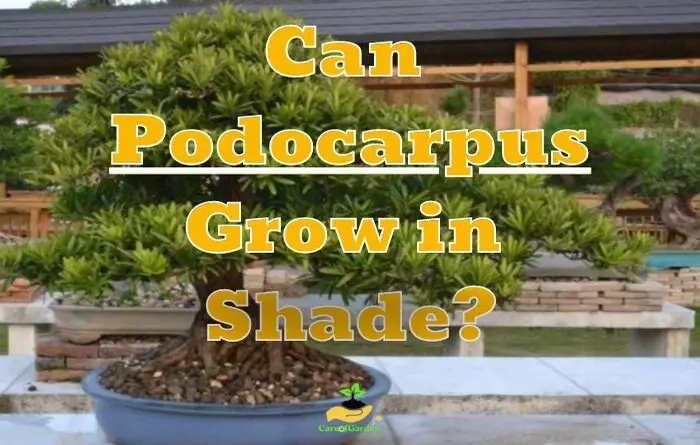Can Podocarpus Grow in Shade? (Quick Answer)
The Podocarpus is wanted for its lush foliage, which consists of small, needle-like leaves ranging in color from bright green to dark green. Podocarpus is also known for its ability to grow in many soil types and is relatively low-maintenance, making it a popular choice for gardeners of all skill levels. One of the questions many gardeners have about Podocarpus is whether or not it can grow in shade.
The short answer is yes, podocarpus can tolerate some shade, but it will grow best in partial shade or full sun. Let’s take a closer look at what this means and how you can ensure your podocarpus plants thrive in your garden, regardless of the light conditions.
Can Podocarpus Grow in Shade?
Podocarpus can tolerate partial shade to full sun conditions but thrives in bright, indirect light. While it prefers full sun, it can still grow and develop well in shaded areas.
In shaded areas, Podocarpus may grow more slowly, and its foliage may be less dense. The lack of sunlight can also make it more susceptible to pests and diseases. Therefore, it is crucial to provide enough light for your Podocarpus if you want it to grow healthy and strong.
To grow Podocarpus (Plum pine) in shaded areas, you can follow these tips:
- Choose the right location – Find a spot with bright, indirect light that receives at least four hours of sunlight a day.
- Prune regularly – Regular pruning can help maintain the density of the foliage and promote healthy growth.
- Avoid overwatering – Podocarpus prefers well-drained soil, so avoid overwatering, which can lead to root rot and other problems.
- Provide proper nutrients – Apply a balanced fertilizer in the growing season to provide your Podocarpus with essential nutrients.
- Monitor for pests and diseases – Regularly inspect your plant for any signs of pests or diseases and take action immediately if detected.
Overall, while Podocarpus prefers full sun, it can still grow and thrive in shaded areas. With proper care and attention, you can grow a healthy and beautiful Podocarpus tree in any environment.
Can Podocarpus Take Full Sun?
Podocarpus is a hardy and versatile plant that can thrive in various growing conditions, including full sun exposure. Planting Podocarpus in full sun can encourage vigorous growth and denser foliage, making it an excellent choice for sunny areas in your garden.
To grow Podocarpus in full sun, select a location that receives direct sunlight for at least six hours a day. This will allow the plant to carry out photosynthesis efficiently and produce energy for growth and development.
One of the benefits of growing Podocarpus in full sun is that it can produce denser foliage than plants grown in shaded areas. Direct sunlight stimulates the production of chlorophyll, which is essential for photosynthesis and gives the leaves their green color. With sufficient sunlight, Podocarpus can produce lush, green foliage that can provide a natural screen or hedge in your garden.
However, it’s crucial to ensure the plant is receiving adequate water to prevent dehydration. In hot and dry climates, you may need to water the plant more frequently to maintain its health and vitality.
Additionally, planting Podocarpus hedge in full sun may make it more susceptible to pests and diseases. Spider mites, scales, and mealybugs are common pests that can infest Podocarpus plants and cause damage to the foliage.
To prevent these issues, you should regularly monitor your plant for signs of infestation and take prompt action to address any problems.
Another potential issue with planting Podocarpus in full sun is the risk of sunburn on the leaves. Prolonged exposure to intense sunlight, especially during the hottest part of the day, can cause sunburn on the leaves.
To prevent sunburn, you should provide some shade or protection for the plant during the hottest part of the day, such as by planting it near other trees or structures that can provide some shade.
Podocarpus is an excellent plant choice for full-sun areas in your garden. By selecting a suitable location, providing adequate moisture, monitoring for pests and diseases, and taking steps to prevent sunburn, you can successfully cultivate a healthy and attractive Podocarpus plant in full sun.
Can Podocarpus Grow Inside?
While Podocarpus is typically grown outdoors in gardens, it can also thrive indoors if provided with the right growing conditions. Indoor Podocarpus plants can add a touch of greenery to your home or office, and their versatility makes them suitable for a variety of indoor settings.
When growing Podocarpus indoors, it’s essential to select a location that receives bright, indirect light. Avoid placing the plant in direct sunlight, as this can scorch the leaves and cause damage to the plant. Instead, choose a location near a window with filtered light, or use artificial grow lights to provide the necessary light.
Podocarpus plants also require consistent moisture to thrive. Water Podocarpus when the soil feels dry to the touch, and be careful not to overwater, as this can cause root rot and other issues.
Additionally, indoor environments can be dry, so you may need to provide extra humidity by placing a tray of water near the podocarpus trees or using a humidifier.
One of the benefits of growing Podocarpus shrubs indoors is that it can be easily maintained at a smaller size. With regular pruning, you can keep the plant compact and prevent it from outgrowing its indoor space.
However, it’s crucial to ensure that the plant still has enough foliage to carry out photosynthesis and produce energy for growth.
Another consideration when growing Podocarpus trees indoors is the potential for pests and diseases. Indoor plants can be more susceptible to certain pests, such as spider mites and scales, due to the lack of natural predators.
Regular monitoring and treatment with natural or chemical remedies can help prevent and address these issues.
Finally, it’s important to note that Podocarpus plants can release pollen that can trigger allergies in some people. If anyone in your household is sensitive to pollen, you may want to consider a different plant or take steps to reduce pollen exposure; such as keeping the plant in a separate room or using an air purifier.
While Podocarpus is typically grown outdoors, it can also thrive indoors if provided with the right growing conditions. Bright, indirect light, consistent moisture, and regular pruning can help keep your indoor Podocarpus plant healthy and attractive. With proper care, your indoor Podocarpus plant can be a beautiful addition to your home or office.
Can Podocarpus Grow in Pots?
Yes, Podocarpus shrubs can grow in pots, but there are some important considerations to keep in mind to ensure the plant’s health and growth. Growing Podocarpus in pots can be an excellent option for those who don’t have access to outdoor garden space or who want to keep the plant at a manageable size.
When selecting a pot for your Podocarpus, choose one slightly larger than the plant’s current root ball. The pot should also have drainage holes to prevent water from accumulating and causing root rot. It’s important to use a well-draining potting mix to allow excess water to drain away from the roots.
Podocarpus trees grown in pots need regular watering, but it’s essential not to overwater. Check the soil regularly and water when the top inch feels dry to the touch. Be careful not to let the soil dry out completely, as this can stress the plant and cause the leaves to yellow and drop.
Fertilization is also crucial for the growth and health of Podocarpus plants in pots. Use a slow-release fertilizer formulated for container plants, and apply it according to the manufacturer’s instructions. Over-fertilization can damage the roots and harm the plant, so be sure to use fertilizer sparingly.
Pruning is essential when growing Podocarpus in pots, as it helps to control the plant’s size and shape. Regular pruning also promotes bushier growth and can prevent the plant from becoming leggy.
Prune the plant in the spring, before new growth appears, and remove any dead, diseased, or damaged branches.
One of the challenges of growing Podocarpus in pots is the potential for the plant to become root-bound. This occurs when the roots outgrow the pot and become tightly packed, limiting the plant’s growth and health.
To prevent this, repot the plant every 2-3 years, or when the roots begin to grow out of the drainage holes.
Another consideration when growing Podocarpus in pots is the potential for pests and diseases. Regular monitoring and treatment with natural or chemical remedies can help prevent and address these issues.
Podocarpus can grow in pots, but it’s important to provide the plant with the right growing conditions, including proper pot size, well-draining soil, regular watering and fertilization, and pruning.
With the right care, your potted Podocarpus plant can be a beautiful and healthy addition to your indoor or outdoor space.
Conclusion
In conclusion, Podocarpus is a versatile plant that can thrive in many growing conditions, including shade, full sun, indoor spaces, and pots. By understanding the plant’s needs and providing essential care, you can enjoy the beauty and benefits of Podocarpus in your home or garden.
Whether you’re looking to create a lush and vibrant landscape or add some greenery to your indoor space, Podocarpus is an excellent choice. With its evergreen foliage, attractive growth habit, and low maintenance requirements, Podocarpus will bring years of enjoyment and beauty to any setting.
Like any plant, Podocarpus macrophyllus requires the ideal light conditions to thrive and stay healthy. It can be placed in windows to receive the right amount of sunlight, although it can survive in the shade.
Podocarpus is a coniferous plant that can measure from half a meter to 2 m in height. Under conditions of natural growth, its tree-like form extends its branches up to 12 m.
Shade-loving varieties:
Eastern: acers or Japanese maples, bamboos;
Exotic: eucalyptus, Mexican orange trees, okubas, and even certain palm trees (chamberops);
Conifers: yews, pines, spruces, cedars.




